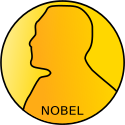James Peebles
| James Peebles | |
 James Peebles, 2010. | |
| Född | Phillip James Edwin Peebles 25 april 1935[1] (89 år) Winnipeg, Kanada |
|---|---|
| Medborgare i | Kanada och USA |
| Utbildad vid | Princeton University University of Manitoba Glenlawn Collegiate |
| Sysselsättning | universitetslärare, fysiker |
| Arbetsgivare | Princeton University |
| Utmärkelser | |
| Royal Astronomical Societys guldmedalj, 1998 Brucemedaljen, 1995 Shawpriset, 2004 Nobelpriset i kemi, 2019 Se lista | |
| Redigera Wikidata | |
Phillip James Edwin Peebles, född 25 april 1935 i Winnipeg, Manitoba, Kanada, är en amerikansk teoretisk fysiker, prisbelönt kosmolog, nobelpristagare i fysik 2019 och läroboksförfattare. Han började studera fysikalisk kosmologi innan ämnet betraktades som en seriös, kvantitativ gren av fysiken och är kanske den som gjort mest för att etablera den som egen respektabel disciplin.
Jim Peebles tog sin grundexamen i fysik 1958 vid University of Manitoba. Han fortsatte till Princeton University, där han doktorerade och så småningom fick sin Albert Einstein-professur. Han är numera professor emeritus vid Princeton.
Han har lämnat många viktiga bidrag till big bang modellen, när det gäller den kosmiska bakgrundsstrålningen, syntesen av atomkärnor, mörk materia och mörk energi. Han har fortlöpande bidragit till teorin om strukturbildning i kosmos. Det hela dokumenterat i vetenskapliga artiklar och böcker. Hans tegelsten ”Physical cosmology” från 1971 är fortfarande en klassiker för forskarstudenter.
Utmärkelser
Peebles har erhållit ett flertal akademiska utmärkelser. Han har även fått asteroiden 18242 Peebles uppkallad efter sig.
- Eddingtonmedaljen, 1981
- Dannie Heineman-priset i astrofysik, 1982[2]
- Petrie Prize Lecture, 1989
- Henry Norris Russell-lektorat, 1993
- Bruce-medaljen, 1995[3]
- Oskar Klein-medaljen, 1997[4]
- Royal Astronomical Societys guldmedalj, 1998
- Gruber-priset i kosmologi, 2000[5]
- Harvey-priset, 2001[6]
- Tomalla-priset, 2003
- Shawpriset i Astronomi, 2004
- Crafoordpriset i astronomi, med James E. Gunn och Martin Rees, 2005[7]
- Dirac-medaljen (ICTP), 2013[8]
 Nobelpriset i fysik, med Michel Mayor och Didier Queloz, 2019[9][10]
Nobelpriset i fysik, med Michel Mayor och Didier Queloz, 2019[9][10] Companion av Kanadaorden, 2020[11]
Companion av Kanadaorden, 2020[11]- Karl G. Jansky Lectureship
Bibliografi (urval)
- B. Rhatra and P. J. E. Peebles, "The Cosmological Constant and Dark Energy", Rev. Mod. Phys. 75, 559 (2003) arXiv:astro-ph/0207347.
- M. Fukugita, C. J. Hogan and P. J. E. Peebles, "The Cosmic Baryon Budget", Astrophys. J. '503, 518 (1998) arXiv:astro-ph/9712020.
- P. J. E. Peebles, Principles of Physical Cosmology (Princeton University Press, Princeton, 1993).
- B. Rhatra and P. J. E. Peebles, "Cosmology with a time-variable cosmological 'constant'", Astrophys. J. 325, L17 (1988).
- B. Rhatra and P. J. E. Peebles, "Cosmological consequences of a rolling homogeneous scalar field", Phys. Rev. D 37, 3406 (1988).
- M. Davis and P. J. E. Peebles, "A survey of galaxy redshifts. V - The two-point position and velocity correlations", Astrophys. J. 267, 465 (1983).
- P. J. E. Peebles, "Large-scale background temperature and mass fluctuations due to scale-invariant primeval perturbations", Astrophys. J. 263, L1 (1982).
- P. J. E. Peebles, The large-scale structure of the universe (Princeton University Press, Princeton, 1980).
- E. J. Groth and P. J. E. Peebles, "Statistical Analysis Of Catalogs Of Extragalactic Objects. 7. Two And Three Point Correlation Functions For The High-Resolution Shane-Wirtanen Catalog Of Galaxies", Astrophys. J. 217, 385 (1977).
- J. P. Ostriker and P. J. E. Peebles, "A Numerical Study of the Stability of Flattened Galaxies: or, can Cold Galaxies Survive?", Astrophys. J. 186, 467 (1973).
- P. J. E. Peebles, Physical Cosmology, (Princeton University Press, Princeton, 1971).
- P. J. E. Peebles and J. T. Yu, "Primeval adiabatic perturbation in an expanding universe", Astrophys. J. 162, 815 (1970).
- P. J. E. Peebles, "Origin of the Angular Momentum of Galaxies", Astrophys. J. 155, 393 (1969).
- P. J. E. Peebles and R. H. Dicke, "Origin of the Globular Star Clusters", Astrophys. J. 154, 891 (1968).
- P. J. E. Peebles, "Primordial Helium Abundance and the Primordial Fireball. II", Astrophys. J. 146, 542 (1966).
- P. J. E. Peebles, “Primordial Helium Abundance and the Primordial Fireball. I", Phys. Rev. Lett. 16, 410 (1966).
- R. H. Dicke, P. J. E. Peebles, P. G. Roll and D. T. Wilkinson, "Cosmic Black-Body Radiation", Astrophys. J. 142, 414 (1965).
Källor
- ^ Brockhaus Enzyklopädie, James Peebles, läst: 9 oktober 2017.[källa från Wikidata]
- ^ läs online, aas.org .[källa från Wikidata]
- ^ läs online, phys-astro.sonoma.edu .[källa från Wikidata]
- ^ Previous Oskar Klein Memorial Lectures, Stockholms universitet, läs onlineläs online.[källa från Wikidata]
- ^ läs online, gruber.yale.edu .[källa från Wikidata]
- ^ läs online, harveypz.net.technion.ac.il .[källa från Wikidata]
- ^ The Crafoord Prize 2005 (på engelska), Crafoordpriset, läs online.[källa från Wikidata]
- ^ läs online, www.ictp.it .[källa från Wikidata]
- ^ Twitter, NobelPrize, läs online.[källa från Wikidata]
- ^ The Nobel Prize in Physics 2019, Kungliga Vetenskapsakademien, Nobelprize.org, 8 oktober 2019, läs onlineläs online, läst: 8 oktober 2019.[källa från Wikidata]
- ^ läs online, www.gg.ca .[källa från Wikidata]
Externa länkar
 Wikimedia Commons har media som rör James Peebles.
Wikimedia Commons har media som rör James Peebles.- Biografi som Bruce medaljör 1995
- Självbiografisk not inför Shaw-priset 2004
- Populärvetenskaplig information om nobelpriset i fysik 2019 från KVA, på svenska
|
Media som används på denna webbplats
Icon of simple gray pencil. An icon for Russian Wikipedia RFAR page.
Författare/Upphovsman: User:Gusme (it:Utente:Gusme), Licens: CC BY-SA 3.0
Vector image of the Nobel prize medal
Författare/Upphovsman: Boroduntalk, Licens: CC BY 4.0
Companion of the Order of Canada ribbon bar. Canada.





